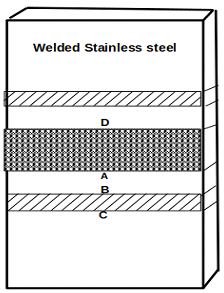This set of Corrosion Engineering Quiz focuses on “Eight Forms – Intergranular Corrosion – 2”.
1. Which of the following is/are the methods to control intergranular corrosion of austenitic stainless steel?
a) Employing solution-quenching
b) Adding stabilizers
c) Lowering the carbon content to below 0.03%
d) Employing solution-quenching, adding stabilizers and lowering the carbon content to below 0.03%
View Answer
Explanation: Austenitic stainless steels are highly prone to intergranular corrosion. It can be minimized by
i. Employing quench-annealing or solution-quenching
ii. Adding stabilizers that forms strong carbides
iii. Lowering the carbon content to below 0.03%
2. Which of the following temperature range is required for commercial solution-quenching treatment?
a) 200°F-500°F
b) 800°F-1200°F
c) 1300°F-1700°F
d) 1950°F-2050°F
View Answer
Explanation: Commerical solution-quenching treatment consists of heating to 1950°F to 2050°F followed by water quenching. Chromium carbide is dissolved at these temperatures, and a more homogenous alloy is formed. It minimizes the susceptibility of weld metal to weld decay.
3. Which of the following is/are the stabilizing elements to minimize intergranular corrosion of stainless steel?
a) Niobium
b) Columbium
c) Titanium
d) Niobium, columbium, and titanium
View Answer
Explanation: Stabilizing elements are the elements that form strong carbides than chromium. These elements have a much greater affinity to carbon than does chromium, this minimizes the chromium depleted zone.
4. Which of the following region is indicated as BC in the given figure?

a) Weld bead
b) Heat affected zone
c) Weld decay
d) Neither weld decay nor bead
View Answer
Explanation: Here in the given figure, region BC represents the weld decay zone and it is exposed to sensitizing temperature range (950°F – 1450°F) during welding. This weld decay zone is highly susceptible to intergranular corrosion.
5. Carbon pickup during the production of austenitic stainless steels has caused premature failures of intergranular corrosion.
a) True
b) False
View Answer
Explanation: Carbon pickup or surface carburization during the production of austenitic stainless steel has caused premature failures. It occurs when these steels are cast into molds that contain carbonaceous materials such as organic binders and baked oil sand. It reduces the corrosive resistance of these steels in the viewpoint of intergranular attack.
6. The intergranular attack is evident in the resin shell casting but not on the ceramic mold casting.
a) True
b) False
View Answer
Explanation: Intergranular attack is evident in the resin shell casting but not on the ceramic mold casting. It is because of organic binders or organic content used for mold making in resin shell casting. It increases the surface carbon content of casting by the phenomenon known as carbon pickup.
7. What is the abbreviation of KLA regarding intergranular corrosion?
a) Knife-Line Attack
b) Knight-Line Attack
c) Knife-Life Action
d) Knight-Life Action
View Answer
Explanation: KLA is abbreviated as Knife-Line Attack. Knife-Line Attack is similar to weld decay in that they both results from intergranular corrosion and both are associated with welding.
8. Which of the following is/are the characteristics of the Knife-line attack?
a) KLA occurs immediately adjacent to the weld
b) KLA occurs in the stabilized steels only
c) KLA occurs in the non-stabilized steels only
d) KLA occurs in the stabilized steels and it occurs immediately adjacent to the weld
View Answer
Explanation: KLA occurs in a narrow band in the parent metal adjacent to weld and it occurs in the stabilized steels that are alloyed with niobium, titanium, and columbium.
9. Which of the following is the best remedy for the Knife-Line attack?
a) Heating the welded stabilized steel in the range of 950°F to 1400°F
b) Heating the welded stabilized steel in the range of 1400°F to 1900°F
c) Heating the welded stabilized steel to 1950°F
d) Heating the welded stabilized steel in the range of 1950°F to 2500°F
View Answer
Explanation: The temperature range of 950°F to 1400°F is the sensitizing zone where only chromium carbide precipitates. Heating the welded stabilized steel to 19500F results in the dissolution of chromium carbide and precipitation of columbium carbide.
10. Which of the following alloys exhibits intergranular corrosion by steam and marine atmospheres?
a) Die-cast zinc alloy
b) Duralumin alloy (Al-Cu)
c) Both die-cast zinc alloy and duralumin alloy
d) Neither die-cast zinc alloy nor duralumin alloy
View Answer
Explanation: Die-cast zinc alloys containing aluminum exhibit intergranular corrosion by steam and marine atmosphere. Whereas duralumin alloys are also susceptible to intergranular corrosion in a different atmosphere.
Sanfoundry Global Education & Learning Series – Corrosion Engineering.
To practice all areas of Corrosion Engineering for Quizzes, here is complete set of 1000+ Multiple Choice Questions and Answers.
If you find a mistake in question / option / answer, kindly take a screenshot and email to [email protected]
- Practice Mechanical Engineering MCQs
- Apply for Mechanical Engineering Internship
- Check Corrosion Engineering Books
- Check Metallurgical Engineering Books
- Practice Metallurgical Engineering MCQs
